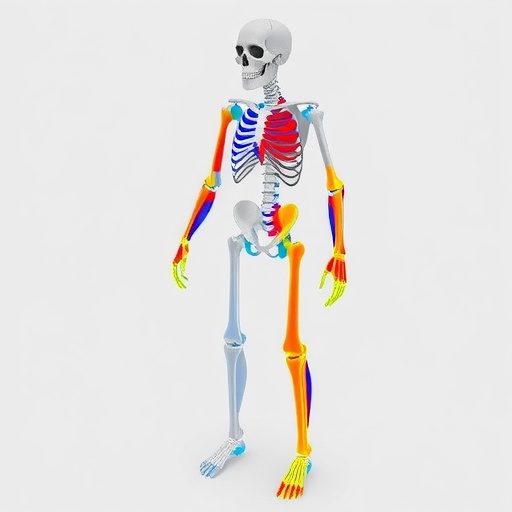In an era where technological advancements continuously reshape our understanding of physiology and biomechanics, a groundbreaking study offers an innovative perspective on exoskeleton design. Published in the premier journal “Annals of Biomedical Engineering,” the research conducted by Riahi, Jasimi Zindashti, Golabchi, and their colleagues investigates the musculoskeletal modeling of a hinge-type back-support exoskeleton. This novel approach aims to simplify practical assessments, making it feasible for widespread application in various settings, from clinical environments to industrial applications.
The research delves into the intricate relationship between human biomechanics and supportive technology, emphasizing that the future of exoskeletons must not only prioritize functionality but also user compatibility and accessibility. By exploring the anatomical and mechanical interactions between the exoskeleton and the human body, the authors present a framework that enhances the understanding of how these systems can effectively augment human capabilities without infringing on natural movement patterns. This is vital in a world where musculoskeletal disorders are increasingly prevalent, impairing quality of life for millions globally.
One of the standout features of this study is the emphasis on a ‘simplified approach.’ Traditional methods of assessing exoskeletal technologies often involve complex simulations and extensive computations that can deter potential users and developers alike. By introducing a methodology that breaks down these barriers, the researchers pave the way for more intuitive designs and evaluations. Their streamlined modeling processes could significantly accelerate the prototyping phases and encourage innovation in exoskeleton design.
The hinge-type back-support device focuses particularly on providing substantial assistance to those with lower back issues, a common ailment in both workplace environments and everyday activities. The motivations behind creating exoskeletons that deliver targeted support align closely with the need to enhance workplace ergonomics, thereby decreasing the incidence of injury and promoting better postural habits. This perspective is particularly relevant amidst the ongoing discourse on occupational health, where the burden of musculoskeletal issues continues to climb, leading to escalated healthcare costs and reduced productivity.
Moreover, the research team employs advanced musculoskeletal modeling techniques to simulate dynamic movements under varied load conditions. This approach enables researchers to identify how effectively the exoskeleton can redistribute the weight and ease the strain placed on the user’s back. The insight gained from such modeling can be invaluable in refining the design of these devices, ensuring they offer maximum support while allowing for freedom of movement, which is essential for user acceptance and performance.
The implications of this research extend beyond the realm of injury prevention. The integration of exoskeleton technology can revolutionize rehabilitation practices, particularly for patients recovering from significant injuries or surgeries. By providing physical assistance and encouraging proper body mechanics, hinge-type exoskeletons can serve as therapeutic tools that facilitate recovery while empowering users through enhanced mobility.
As the study discusses, the feasibility of widespread deployment hinges on alignment with end-user needs. User-centered design principles must be embraced to create devices that not only serve a functional purpose but also appreciate aesthetic qualities and comfort. This is crucial, especially for users who may initially be hesitant to adopt exoskeleton technology. By ensuring that such devices meld seamlessly with the everyday experience of the user, developers can inspire confidence and enthusiasm for the integration of assistive technologies into daily life.
In addressing the need for practical assessments, the researchers suggest incorporating a variety of real-world testing scenarios that mirror genuine conditions where users would wear the exoskeleton. This type of validation is essential for demonstrating the capabilities and benefits of the device in the field. Potential applications range from manual labor jobs that require heavy lifting to rehabilitation programs aimed at restoring mobility and strength in affected individuals.
The study’s multidisciplinary perspective encourages collaboration among biomechanical engineers, medical professionals, and technologists. By leveraging expertise from diverse fields, a more thorough understanding of the multifaceted challenges presented by musculoskeletal disorders can be achieved. This collaboration is vital in maintaining a patient-centric approach that prioritizes user safety, comfort, and real-world efficacy.
In an increasingly technology-dependent world, solutions that not only advance science but also resonate with human experience are paramount. As exoskeletons continue to evolve, studies like this underscore the importance of research that revolves around practical application rather than pure theoretical advancement. This proactive stance could lead to faster acceptance and integration of exoskeleton technologies across various sectors, enhancing productivity and improving overall well-being.
The findings outlined in this study push the boundaries of our understanding and set the stage for future research that continually seeks to optimize the integration of technology and human ergonomics. With musculoskeletal disorders rising rapidly, the societal need for effective and accessible solutions has never been more critical. Riahi and colleagues’ research is a testament to the promising future of biomechanical engineering, one where innovation is tailored to the human experience.
As attention turns towards the practical implementations of such technologies, the onus will be on researchers, developers, and policymakers to ensure that these advancements are backed by solid data, user feedback, and ongoing clinical validation. Ensuring that hinge-type exoskeletons align with contemporary health standards can influence their adoption significantly, making a direct impact on health outcomes and quality of life for individuals suffering from musculoskeletal issues.
In conclusion, as we look ahead at the intersection of technology and human physiology, studies like “Musculoskeletal Modeling of a Hinge-Type Back-Support Exoskeleton” illustrate the vision and potential for exoskeletons to contribute to a healthier, more productive society. With ongoing advancements in modeling and design, it is evident that these technologies are not just futuristic concepts but are set to become integral tools in enhancing human performance and wellness in our everyday lives.
Subject of Research: Musculoskeletal modeling of a hinge-type back-support exoskeleton.
Article Title: Musculoskeletal Modeling of a Hinge-Type Back-Support Exoskeleton: A Simplified Approach for Practical Assessment.
Article References:
Riahi, N., Jasimi Zindashti, N., Golabchi, A. et al. Musculoskeletal Modeling of a Hinge-Type Back-Support Exoskeleton: A Simplified Approach for Practical Assessment.
Ann Biomed Eng (2025). https://doi.org/10.1007/s10439-025-03888-8
Image Credits: AI Generated
DOI: https://doi.org/10.1007/s10439-025-03888-8
Keywords: Exoskeletons, Musculoskeletal modeling, Back support, Biomechanics, Rehabilitation technology.




